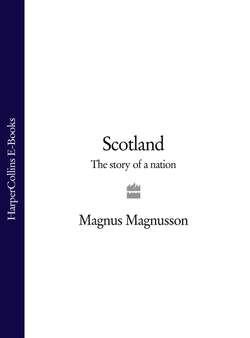Читать книгу Scotland: The Story of a Nation - Magnus Magnusson - Страница 12
Calanais (Isle of Lewis): 3000–2000 BC
ОглавлениеIt used to be called ‘Callanish’ or ‘Callernish’. Before that it was ‘Classerniss’. But now the original Gaelic form of the name will be enshrined in the next Ordnance Survey maps of the Western Isles of Scotland, so ‘Calanais’ it is, officially.
Calanais on the Isle of Lewis lies at the head of Loch Roag, some twenty-four kilometres west of Stornoway. It was built in stages from about 3000 BC and was certainly completed by 2000 BC. Briefly, it is a circle of thirteen standing stones huddled round a massive central monolith, 4.75 metres high, and a small chambered cairn. A double line or ‘avenue’ of stones comes in from the north, and ragged tongues protruding from the circle create a rough cruciform shape.
The importance of Calanais has long been recognised. In the seventeenth century the people of Lewis called the standing stones Fir Bhrèige (‘False Men’):
It is left by traditione that these were a sort of men converted into stone by ane Inchanter. Others affirme that they were sett up in places for devotione.
JOHN MORISONE OF SOUTH BRAGAR, c.1684
By then the complex had been all but drowned in a layer of peat some 1.5 metres deep. In 1857 the owner of Lewis, Sir James Matheson, ordered the peat to be cleared, and the site became a Mecca for visitors. When the first Ancient Monuments Act was passed in 1882, Calanais was in the primary list of sixty-three prehistoric or later monuments to be scheduled for protection.
The landscape setting, and the setting of the stones themselves, have changed considerably since then. The local inhabitants, who had lived in a row of crofting houses built in the 1860s at the southern edge of the site, were ‘cleared’, like the peat. Various excavations of dubious value were undertaken. Early in the 1980s a ‘proper’ excavation was mounted, led by Patrick Ashmore of Historic Scotland, to clarify the precise positions of fallen and missing stones and to repair and conserve the site; in 1982, in a BBC documentary to celebrate the centenary of the Ancient Monuments Act (Echoes in Stone), I filmed the tricky re-erection of one of the stones at Calanais.1 There is now a new Calanais Visitor Centre next door to the Edinburgh University Field Centre; here, visitors can find out about the main site before going on to admire the stones in situ.
Calanais has a special aura of enchantment, of marvel and majesty and mystery. What was it originally intended to be? That is its continuing enigma. A temple? A huge funerary complex? A megalithic astronomical observatory to mark important events in the movements of the sun and the moon and the stars? Or all three, perhaps? The engineering and surveying skills required to construct such a complex monument are astonishing; they argue a high level of sustained social organisation, and the sophisticated and purposeful use of regional power to express ancient beliefs and rituals which we still cannot fathom.
These beliefs and rituals were given their most impressive and enduring monument in the great prehistoric chambered tomb of Maes Howe, at Tormiston Mill on the Orkney mainland.
